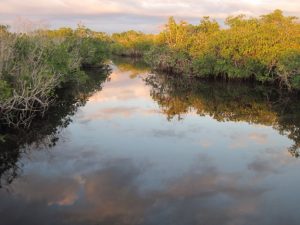Everglades ‘remembers’ severe weather
By National Science Foundation2/6/2020

Mangroves in Florida’s Shark River before a cold snap hit the Florida Coastal Everglades LTER site. Photo Credit: Jennifer Rehage, NSF.
The chemical signature left behind by hurricanes, fires, cold snaps and droughts can linger in the slow-moving water of the Florida Everglades for up to a decade, researchers report.
No one expected evidence of these disturbances to be detectable in the water for so long and to spread across different areas of the Everglades, the scientists say. Increased levels of phosphorus, nitrogen, bacterial production and dissolved carbon were found in water data collected from 2000 to 2017 at the Florida Coastal Everglades Long-Term Ecological Research site supported by the National Science Foundation. The discovery could influence water management of the Everglades.
“That we can use long-term data to sense that a disturbance happened means it must be having an important role in the system,” says Florida International University ecologist John Kominoski, the study’s lead author. “Otherwise, it would be overwhelmed by ‘noise’ instead of these clear signals.”
Hurricane Wilma in 2005. Fire in 2008. A cold snap and a drought in 2010. Another cold snap in 2011. A drought and excessive flooding in 2015. Hurricane Irma in 2017. Each of these disturbances left unmistakable, traceable signals in the chemistry of the water winding through the Everglades.
Read more here: nsf.gov/discoveries/disc_summ.jsp?cntn_id=299983&org=NSF&from=news
Read the article in Ecology: https://esajournals.onlinelibrary.wiley.com/doi/abs/10.1002/ecy.2988?campaign=wolacceptedarticle